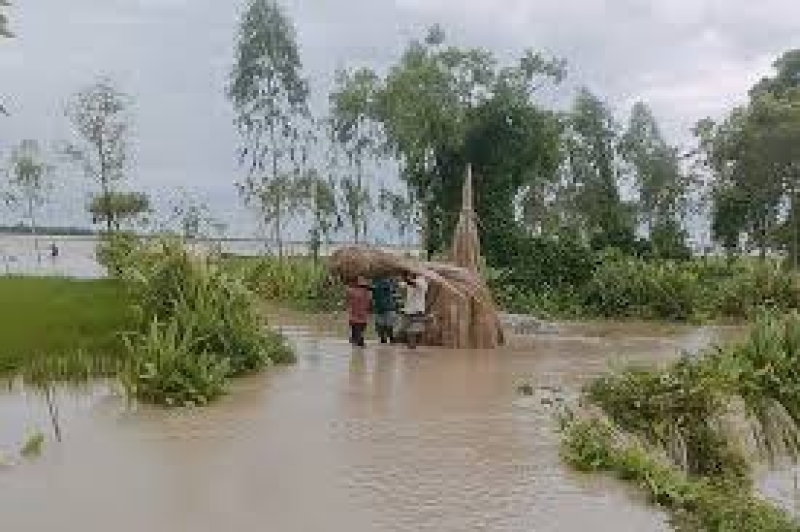- Tarique Vows to Return, be With People During Polls |
- Exports Dip 4.5pc in September Amid US Tariff Impact |
- Hamas calls for swift hostage-prisoner swap as talks set to begin |
- Leadership vacuum cripples primary education in Sonargaon |
- Tornado destroys over 500 houses in Nilphamari, injures 30 |
Teesta Floods Submerge Low-lying Areas in Lalmonirhat

Floodwaters from the swelling Teesta River have inundated areas in Dahagram Union of Patgram upazila: Photo collected
Heavy rainfall and strong upstream runoff have caused the Teesta River to overflow its banks, flooding low-lying areas in Lalmonirhat’s Hatibandha and Patgram upazilas. The river is now flowing 10 centimetres above the danger level, leaving thousands of families stranded and damaging homes, crops, and infrastructure.
According to the Water Development Board (WDB), floodwaters have entered six unions of Hatibandha upazila and Dahagram Union of Patgram upazila, disrupting daily life and communication in the affected areas.
WDB issues red alert
The WDB has issued a red alert, warning residents living near the Teesta River to move to higher ground. Using loudspeakers, local authorities are urging people in vulnerable areas to evacuate immediately to avoid potential danger.
Officials said the Teesta Barrage at Dalia point recorded a water level of 52.25 metres at 6:00 pm on Sunday, which is 10 centimetres above the danger mark of 52.15 metres. The level had been below the danger threshold earlier in the day, but it rose rapidly due to heavy rainfall and strong inflow from upstream regions.
Thousands stranded, crops damaged
Around 2,500 families in Hatibandha and Patgram upazilas have become marooned as floodwaters submerged roads, homes, and farmlands. Early Aman paddy, winter vegetables, and fish ponds have been badly affected, causing concern among local farmers.
In Hatibandha’s Charsindurna, Sindurna, Gaddimari, Goddimari, and Dawabari unions, floodwater has inundated low-lying villages and chars. Similarly, in Dahagram Union of Patgram upazila, more than 500 families in Munshipara, Clinicpara, Kaderer Char, Mohimpur, Charpara, Katipara, and Sayedpara have been trapped by rising waters.
Enamul Haque, a resident of Charsindurna village, said his family’s home is now under water. “We have moved our children and valuables to a relative’s house on higher ground. The situation is getting worse by the hour,” he said.
Amir Hossain from Katipara village shared a similar story, saying floodwater has entered his home, making cooking and movement difficult. “We can’t go to the market as the roads are submerged. One bridge nearby has already been damaged,” he added.
Authorities on high alert
Hatibandha Upazila Nirbahi Officer (UNO) Md Shamim Mia said the upazila administration is on full alert and taking necessary measures to protect residents and minimise damage.
“The river water is still rising, and several unions have been affected. Around two thousand families are now stranded. Relief preparations are underway, and both district and upazila administrations are working to ensure safety,” he said.
Sunil Kumar, executive engineer of the Lalmonirhat WDB office, said continuous heavy rainfall and strong upstream flows have led to the sharp rise in the Teesta’s water level. “The river is now flowing 10 centimetres above the danger mark, and if the rainfall continues, more areas could be flooded,” he warned.
More rain expected
The Flood Forecasting and Warning Centre (FFWC) has predicted further rainfall over the northern region. It said that continued heavy showers on Sunday and Monday may cause water levels in the Teesta, Dharla, and Dudhkumar rivers to rise further, threatening riverine areas in Lalmonirhat, Nilphamari, and Rangpur districts.
Local residents have begun moving their livestock and belongings to higher ground as water levels continue to rise. Volunteers and local disaster management teams are preparing for potential relief operations if the situation worsens.
The growing flood risk
With the Teesta and other northern rivers swelling each monsoon, experts have called for permanent flood control measures, including improved embankments and modernised river management systems.
As Bangladesh faces increasingly erratic weather patterns due to climate change, officials fear that floods like this could become more frequent and intense in the coming years, posing fresh challenges to communities along the Teesta basin.

